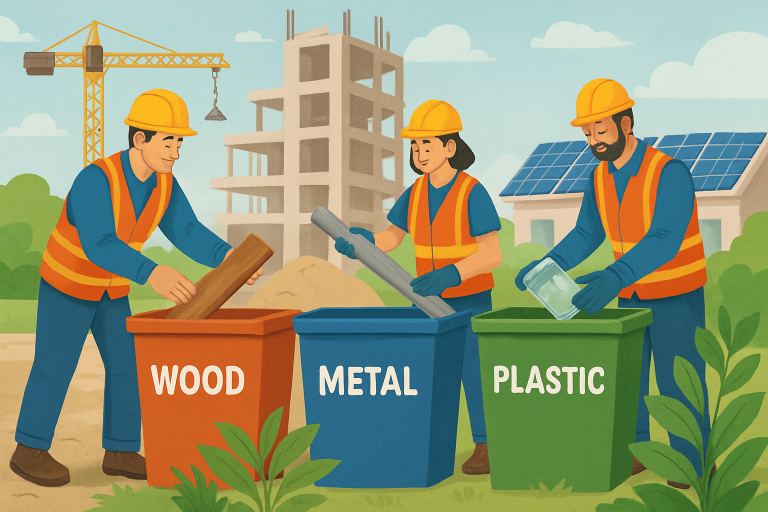Key Takeaways
- Utilizing recycled and renewable materials minimizes waste and conserves resources.
- Advanced sorting technologies improve the efficiency of recycling construction debris.
- Deconstruction methods facilitate material reuse and reduce landfill contributions.
- Energy-efficient designs and water conservation strategies contribute to sustainable construction practices.
As environmental awareness continues to shape the construction industry, sustainable cleanup practices have become essential for minimizing ecological footprints and maximizing efficiency. From the materials chosen to the technologies implemented, every decision during the construction process can affect the planet for decades to come. By embracing responsible cleanup techniques, industry professionals can ensure cleaner build sites and higher standards for post-construction cleaning that protect both the environment and community well-being. These practices not only improve sustainability but also support compliance with regulatory guidelines and certifications that set projects apart in an increasingly eco-conscious market.
Utilizing eco-friendly post-construction solutions involves more than debris removal—it’s about embedding environmental responsibility in every step. Modern cleanup includes recycling, reuse, resource conservation, and advanced sorting, crucial for sustainability. Green projects create healthy spaces while reducing waste, conserving resources, and lowering emissions from the start.
Adopting such holistic approaches involves a commitment to continuous improvement, education, and innovation within the building industry. When projects are properly cleaned up and prepared using sustainable practices, the surrounding environment and future building users reap benefits for years to come.
In addition, maintaining healthy and durable surfaces is an important aspect of overall green building maintenance. Partnering with specialists who offer premium floor care services ensures that all types of flooring remain safe, appealing, and efficient to clean, maintaining sustainability standards far beyond project turnover.

Utilizing Recycled and Renewable Materials
Choosing building and cleanup materials impacts a project’s sustainability. Using recycled and renewable resources, like reclaimed wood, recycled steel, and bamboo, reduces reliance on finite raw materials, supports a circular economy, and lessens environmental impact. According to the EPA, construction creates over 600 million tons of debris annually in the U.S., much of which can be recycled. Recycled steel saves up to 75% energy compared to new steel, and bamboo’s rapid growth makes it a durable, sustainable alternative to hardwoods.
Implementing Advanced Sorting Technologies
Waste management during construction cleanup now uses advanced sorting technologies like automated conveyors, robotics, and AI systems to identify and separate materials such as concrete, metals, plastics, and wood efficiently. Material recovery facilities (MRFs) employ sophisticated sorting to improve recycling, reduce contamination, and increase reuse. These innovations support sustainability and cut costs through lower tipping fees and higher material recovery. The World Economic Forum states, “Technology solutions to recycling are paving the way for a more circular construction sector,” helping close resource loops and reduce environmental impact.
Adopting Deconstruction Methods
Traditional demolition generates excessive waste and destroys usable materials. Deconstruction, however, involves careful dismantling to preserve components for reuse or recycling. This approach is increasingly adopted by cities and states, as seen in Portland, Oregon, where it offers environmental and economic benefits. Labor-intensive disassembly salvages materials like old-growth timber, hardware, and bricks for reuse, reducing landfill waste, fostering a market for reclaimed products, and supporting local jobs.
Incorporating Energy and Water Conservation Strategies
Effective, sustainable cleanup involves the design and operation of the building. Energy-efficient features like better insulation, energy-saving HVAC and lighting, and renewable energy reduce the carbon footprint from the start. Water conservation through low-flow fixtures, gray water recycling, and rainwater harvesting also helps conserve resources. When cleanup crews focus on these measures and educate owners, significant cost and environmental benefits follow. These practices are recognized in standards like LEED, highlighting their role in sustainable building.
Conclusion
Long-term environmental stewardship in construction hinges on the adoption of sustainable cleanup practices. Builders and property owners support resource efficiency and ecological preservation by integrating recycled materials, utilizing advanced sorting systems, favoring deconstruction over demolition, and embracing energy and water conservation. With increasing industry regulations and consumer expectations, implementing these methods is not just recommended—it’s essential for meaningful progress toward a greener, more responsible future.
